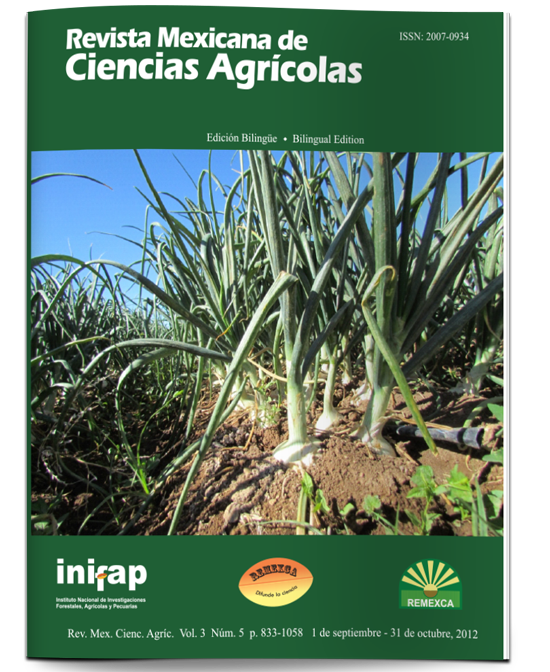Effect of inoculation with rihizospheric bacteria in two varieties of wheat Phase II: greenhouse
DOI:
https://doi.org/10.29312/remexca.v3i5.1408Keywords:
Azospirillum, Sinorhizobium, foliage chlorophyll, phytohormonesAbstract
The experiment was carried out in a greenhouse so that the inoculation, both simple and combined (with the rhizospheric bacteria- Sinorhizobium and Azospirllium), en two varieties of Wheat. Materials and methodologies were used in accordance with previously prescribed conventional methodologies for this study. The experimental design was completely randomized, with 4 replicas and 10 treatments. A statistical analysis using two-way variance was done. Fertilized treatment was applied with NH4NO3 (150 ppm/kg soil). The content of chlorophyll foliage was evaluated, dry air weight, dry root weight, length of stem, and germination. In the event that differences appeared, it was determined through use of the Duncan Test, and the differences between varieties with t-Student. It is concluded that combined inoculation with the strain A2 (Sinorhizobium meliloti) and the strain N7 (Azospirillum zeae) had the greatest positive inf luence on the chlorophyll content of the plants. On the other hand, there was a great difference between the two varieties of wheat in terms of length of stem, dry air weight, and dry root weight. The results of dry air weight and dry root weight, upon combining the two factors that were studied, highly depended on the varietal characteristics of the plant and on the native population of rhizobacteria. The germination of the plants was not linked to any of the applied factors in the experiment.
Downloads
Downloads
Published
How to Cite
Issue
Section
License
The authors who publish in Revista Mexicana de Ciencias Agrícolas accept the following conditions:
In accordance with copyright laws, Revista Mexicana de Ciencias Agrícolas recognizes and respects the authors’ moral right and ownership of property rights which will be transferred to the journal for dissemination in open access. Invariably, all the authors have to sign a letter of transfer of property rights and of originality of the article to Instituto Nacional de Investigaciones Forestales, Agrícolas y Pecuarias (INIFAP) [National Institute of Forestry, Agricultural and Livestock Research]. The author(s) must pay a fee for the reception of articles before proceeding to editorial review.
All the texts published by Revista Mexicana de Ciencias Agrícolas —with no exception— are distributed under a Creative Commons License Attribution-NonCommercial 4.0 International (CC BY-NC 4.0), which allows third parties to use the publication as long as the work’s authorship and its first publication in this journal are mentioned.
The author(s) can enter into independent and additional contractual agreements for the nonexclusive distribution of the version of the article published in Revista Mexicana de Ciencias Agrícolas (for example include it into an institutional repository or publish it in a book) as long as it is clearly and explicitly indicated that the work was published for the first time in Revista Mexicana de Ciencias Agrícolas.
For all the above, the authors shall send the Letter-transfer of Property Rights for the first publication duly filled in and signed by the author(s). This form must be sent as a PDF file to: revista_atm@yahoo.com.mx; cienciasagricola@inifap.gob.mx; remexca2017@gmail.
This work is licensed under a Creative Commons Attribution-Noncommercial 4.0 International license.



